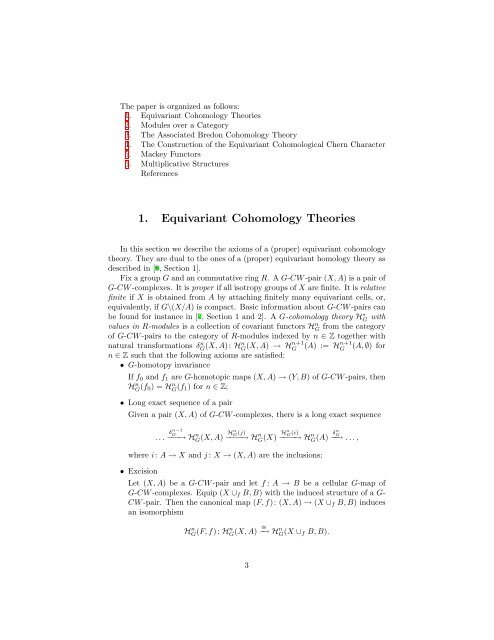Equivariant Cohomological Chern Characters
Equivariant Cohomological Chern Characters
Equivariant Cohomological Chern Characters
Create successful ePaper yourself
Turn your PDF publications into a flip-book with our unique Google optimized e-Paper software.
The paper is organized as follows:1. <strong>Equivariant</strong> Cohomology Theories2. Modules over a Category3. The Associated Bredon Cohomology Theory4. The Construction of the <strong>Equivariant</strong> <strong>Cohomological</strong> <strong>Chern</strong> Character5. Mackey Functors6. Multiplicative StructuresReferences1. <strong>Equivariant</strong> Cohomology TheoriesIn this section we describe the axioms of a (proper) equivariant cohomologytheory. They are dual to the ones of a (proper) equivariant homology theory asdescribed in [8, Section 1].Fix a group G and an commutative ring R. A G-CW -pair (X, A) is a pair ofG-CW -complexes. It is proper if all isotropy groups of X are finite. It is relativefinite if X is obtained from A by attaching finitely many equivariant cells, or,equivalently, if G\(X/A) is compact. Basic information about G-CW -pairs canbe found for instance in [7, Section 1 and 2]. A G-cohomology theory HG ∗ withvalues in R-modules is a collection of covariant functors HG n from the categoryof G-CW -pairs to the category of R-modules indexed by n ∈ Z together withnatural transformations δG n (X, A): Hn G (X, A) → Hn+1G(A) := Hn+1G(A, ∅) forn ∈ Z such that the following axioms are satisfied:• G-homotopy invarianceIf f 0 and f 1 are G-homotopic maps (X, A) → (Y, B) of G-CW -pairs, thenH n G (f 0) = H n G (f 1) for n ∈ Z;• Long exact sequence of a pairGiven a pair (X, A) of G-CW -complexes, there is a long exact sequence. . . δn−1 G−−−→ HG(X, n A) Hn G−−−−→ (j)HG(X) n Hn G−−−−→ (i)HG(A) n δn G−→ . . . ,where i: A → X and j : X → (X, A) are the inclusions;• ExcisionLet (X, A) be a G-CW -pair and let f : A → B be a cellular G-map ofG-CW -complexes. Equip (X ∪ f B, B) with the induced structure of a G-CW -pair. Then the canonical map (F, f): (X, A) → (X ∪ f B, B) inducesan isomorphismH n G(F, f): H n G(X, A) ∼= −→ H n G(X ∪ f B, B).3
















